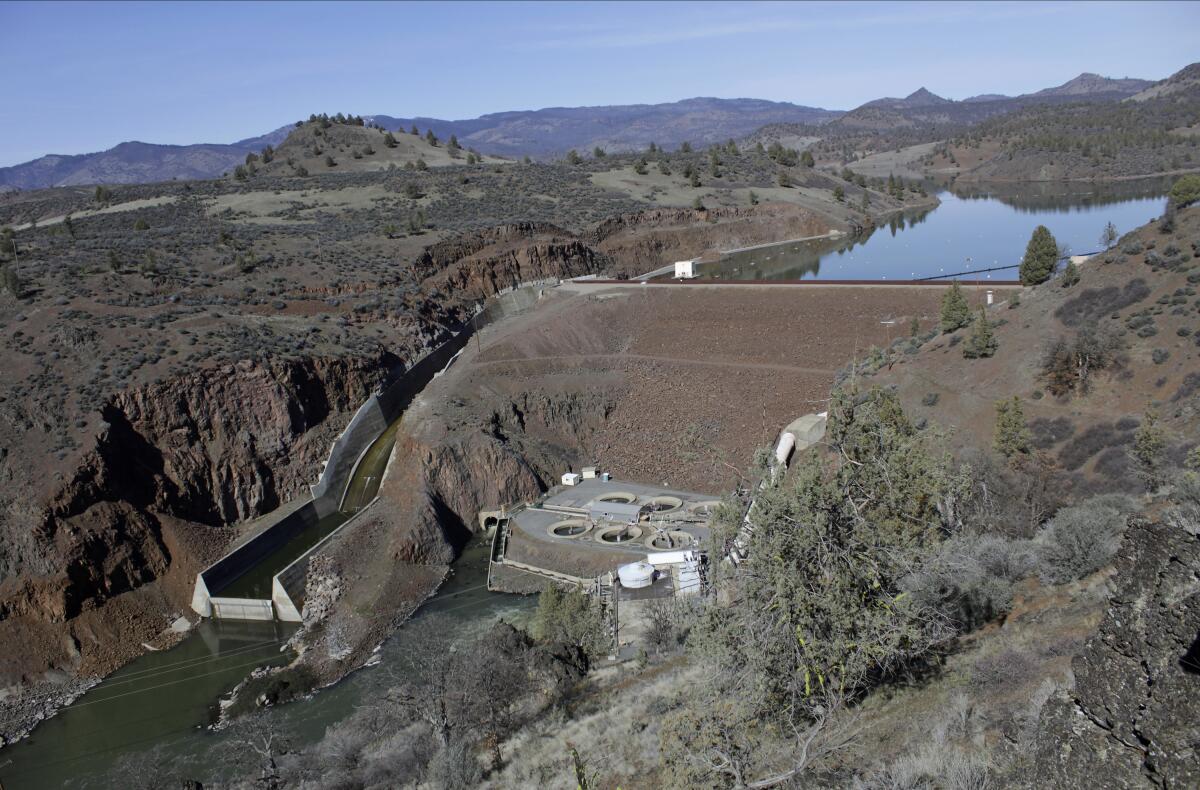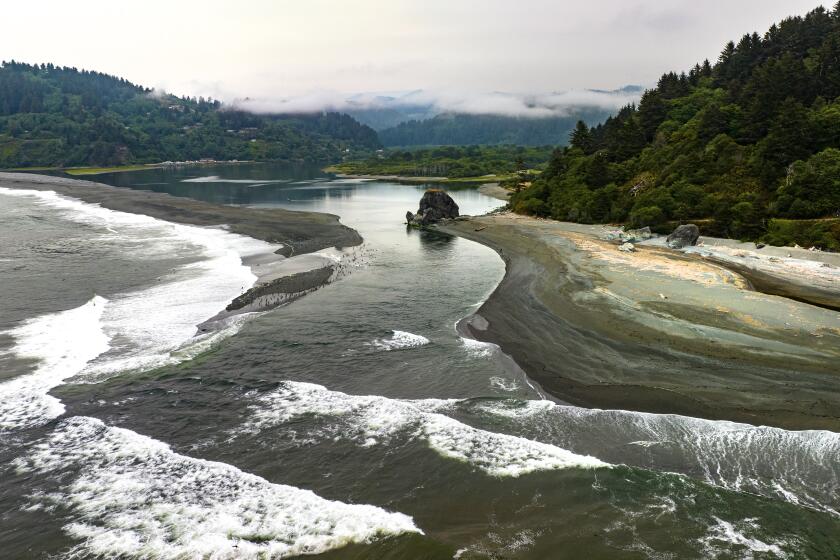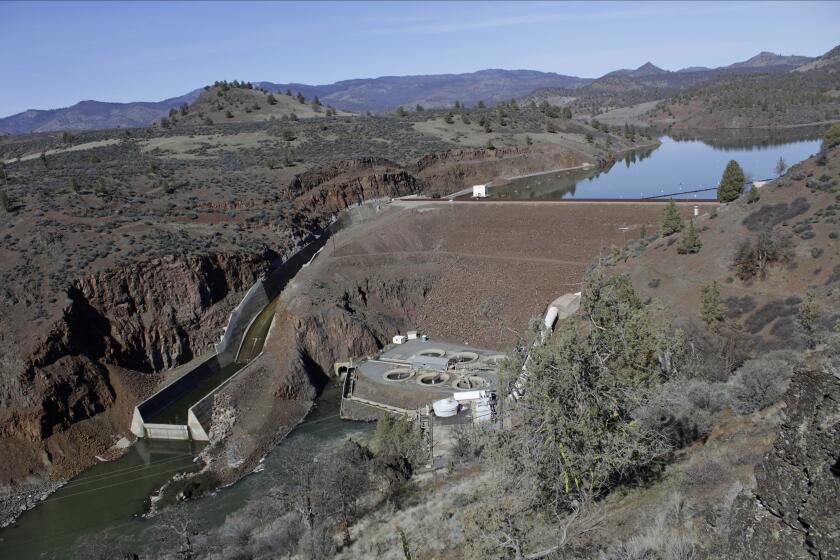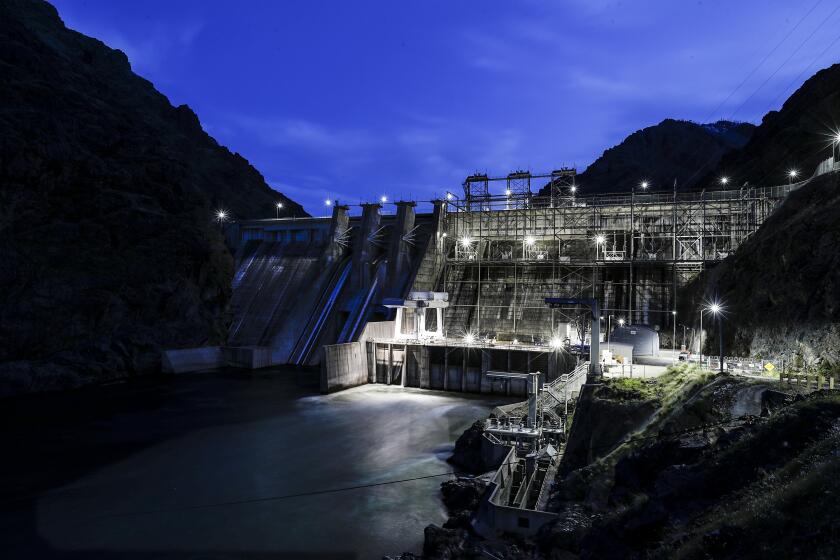Opinion: American dams are being demolished. And nature is pushing that along

- Share via
This summer, the first of four dams on the West’s Klamath River was destroyed, unleashing a torrent of cold water that had been held back for a century. By the end of 2024, three more dams near the California-Oregon border will come down, restoring the massive runs of salmon and steelhead along some 400 miles that once defined the river basin.
For more than a hundred years, dams in the American West have created vast reservoirs, sources of hydroelectric power and irrigation for farms and ranches. But after declining in their power output and providing unpredictable sources of water — not to mention their massive environmental damage to fish, Native American cultures and the land itself — they are coming down from Connecticut to California.
Native activists fought for years to build support for taking down dams on the Klamath River in Northern California. Now, they hope removing the dams will help save their salmon.
More than 1,600 American dams have been removed since 1912. In recent years a slew of ambitious removals have been proposed, including a plan to decommission Glen Canyon Dam on the Colorado River — an idea surprisingly supported not just by environmentalists but farmers too. Once the height of engineering marvels, the great dams of the early 20th century have outlasted their questionable usefulness. Only 50 years ago this reversal was the fringe hope of people like Edward Abbey, the radical environmentalist, writer and imaginer of a reborn West, who wrote: “All dams are ugly, but the Glen Canyon Dam is sinfully ugly.”
Something Abbey didn’t live to see — he died in Oracle, Ariz., in 1989 — was that practicality, not aesthetics, would spell the demise of these giant concrete structures holding back free-flowing rivers. As dams increasingly clogged with silt and went decades without maintenance, their abilities to generate power and release water fell — and the risk of catastrophe rose. In the East, too, their primary achievement has been constraining the populations of Atlantic salmon. Today, their downfall is all part of the rewilding of America, long overdue. Thankfully, the end of the damned dam is finally here.
The Klamath is a perfect example. It has long been not just a river but also a highway for salmon and steelhead. The fish hatched in the upper reaches of Northern California and southern Oregon and made their way into the cold, tumultuous waters of the Pacific Ocean, where the survivors would grow to adulthood and then at mating age use their DNA and strong sense of smell to return back up the river to their birthing grounds. Around the river grew rich Native American cultures, including the Klamath, Modoc, Yahooskin-Paiute, Yurok and Karuk tribes.
In a welcome harbinger for fish, tribes and the environment, four Klamath River Basin dams will finally come down.
But as America changed the West, it destroyed the rivers. Among the earliest dams was Elephant Butte on the Rio Grande in New Mexico, which foreshadowed other vast engineering projects including the Hoover Dam in the early 20th century. A variety of rationales for this construction emerged, such as controlling floods that devastated new settlements and towns. But there were other reasons: In the arid West, water was a commodity to be bought, sold and bartered, especially to farmers who cultivated thirsty crops and orchards where none had existed.
Of course, the Colorado River was especially attractive for dam construction given its length, volume and importance in the Southwest. But as John Fleck and Eric Kuhn explored in their book about the Colorado, “Science Be Damned,” dams and other development overestimated the amount of water the river could offer.
Back in Northern California, the four dams on the Klamath were built strictly for power generation, not water storage. But much as the Colorado was expected to provide unending reserves of water, the Klamath dams were slated to generate massive amounts of power in perpetuity. Not factored in was that rivers discharge silt, which built up over the decades behind the four dams. As of last year they accounted for less than 2% of the power supplied by their controlling utility. Further, with renewable energy sources, there are simply cheaper ways to generate power than relying on massive structures that require expensive maintenance.
One of America’s reddest states is seeking 100% clean energy. But does hydropower count as clean?
On the Klamath, as elsewhere, Native American people have proved crucial to undermining the harms from the mega-engineering projects of a century ago. They have worn away at entrenched economic interests and made alliances with environmentalists, ranchers and farmers to free the Klamath and assert their ancestral rights to the river and the bottomland that will be restored as the reservoirs drain away.
Abbey not only predicted the eventual removal of Glen Canyon Dam on the Colorado; he also noted that time itself inexorably wore down the constructions of humans: “Let the engineers build fifty more dams between here and the Rockies, they can only retard, they cannot stop, the irresistible processes of erosion and renewal. The mountains and plateaus will continue to be uplifted, the rains and snows will fall, the waters will plunge downward back to their source, again and again and again.” That’s proving true today.
Richard Parker is the author of “Lone Star Nation” and a forthcoming narrative history of the Southwest, “The Crossing.”
More to Read
A cure for the common opinion
Get thought-provoking perspectives with our weekly newsletter.
You may occasionally receive promotional content from the Los Angeles Times.













